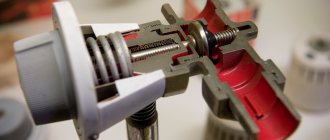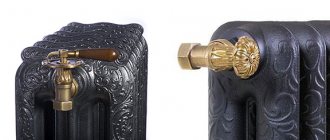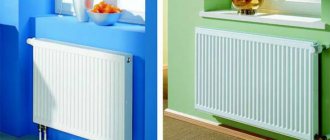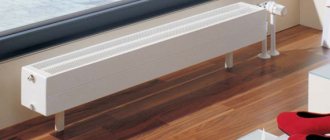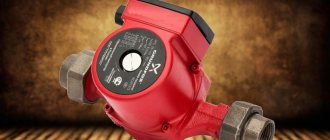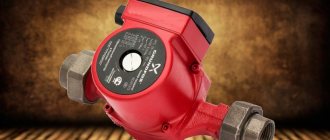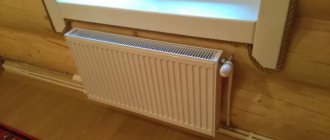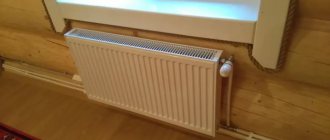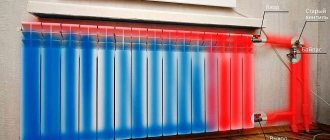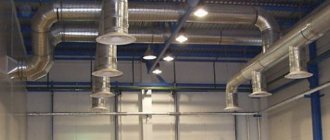A modern heating system for a private home is unthinkable without special shut-off and control valves on batteries. It allows not only to optimize the operation of equipment and extend its service life, but also to significantly reduce energy costs and increase the level of home comfort. Let's consider what taps for heating radiators exist, what their features are and what they are intended for, what requirements are imposed on them and how to select and install them correctly.
Faucet for installation on a heating radiator Source eurosantehnik.ru
Purpose, functions, requirements
During everyday use of the heating system, situations often arise when the supply of coolant to the battery needs to be reduced or stopped altogether. Moreover, in some cases, the presence of a special mechanism that regulates the operating parameters of the equipment is simply necessary and is provided for by the heating device. Therefore, the radiator tap is necessary to maintain the functionality of the system as a whole.
Functions
Radiator taps installed at various points in the circuit allow you to perform the following set of functions:
- De-energize a single section or a specific battery without having to disconnect the entire pipeline. This is very relevant for maintenance, replacement and adjustment procedures.
- Increase or decrease the flow of coolant through the radiator - to regulate the air temperature parameters in the room.
- Protect pipes and devices from possible sudden pressure surges in the network - water hammer.
- Bleed any air pockets that have formed.
- Drain the coolant.
- Control the coolant flow when the bypass is turned off.
- Monitor the level of energy consumption for heating - manually using a thermometer or automatically using thermostat sensors.
Setting up battery parameters Source stoydiz.ru
Note! With the help of radiator taps, you can limit the heat supply or completely shut off those branches of the heating system that are little used or at some times not used at all. This could be a utility room, basement, garage, greenhouse, etc. Special automatic valves cope with this task even more efficiently, as they operate from the settings of temperature sensors. Compared to unregulated heating, they save from 20 to 50% of energy resources.
Requirements
Shut-off and control valves of heating systems operate under rather unusual conditions. It should be more reliable than that used in standard water supply systems. Therefore, taps for radiators must meet the following series of requirements:
- Maintains performance when heated to 200 °C.
- Resistant to internal pressure up to 40 bar.
- High protection of surfaces against corrosion.
- Low sensitivity to mechanical loads.
Direct valve for installation on a radiator Source cloudinary.com
Taking into account the given set of parameters, it is unacceptable to install sliding or shielding type mechanisms in the heating circuit of a private house. The best choice for shut-off valves are ball modifications or valves with a cone gate - for manual adjustment, and valve-cone valves - for automatic control.
The need to disconnect
Before moving on to the diagram for disconnecting the battery from the riser in an apartment building, we suggest considering the basic reasons that can cause a malfunction of the heating system.
Here is a list of the most likely reasons for a battery disconnection:
- an emergency situation that threatens to flood your and your neighbor’s apartment with hot coolant;
- painting radiators in the cold season, when the heating is already on;
- if there is a need to change the radiator or flush it;
- In winter, the radiators are too hot and you want to lower the room temperature.
In some apartments, residents practice shutting off radiators in the summer without draining the coolant in order to protect radiators from blockages when the heating system is turned on in the fall. At this time, water often flows through the pipes with rust fragments. We will tell you how to do this correctly in one of the sections of this article.
Varieties
In modern private houses, the following 4 types of shut-off and control valves are used for radiators:
- Ball overlapping.
- Regulator valves.
- Thermostat valves.
- Air removal mechanisms.
Let us examine in detail their structure, scope of application and operating features.
Ball
Ball valves for heating are classified as shut-off valves. They function only in opposite positions - open or closed. With their help, it is impossible to reduce or increase the coolant flow - but only to completely open or shut off. Therefore, their main area of application is a place where, if necessary, you need to quickly stop the water supply, for example, in front of a battery - when it needs to be replaced or repaired, and also in the event of a leak - the device will quickly shut off the flow.
Ball valve Source aqua-therm.org
See also: Catalog of companies that specialize in engineering systems (heating, water supply, sewerage and others) and related work
The design of the mechanism is based on a steel ball with a through hole. It is connected directly to the handle. In the open position, coolant flows through it. When the handle is turned at a right angle, the spherical element also turns 90 ° and completely stops the flow.
Ball valves are classified according to the following characteristics:
- Type of material. As a rule, the body is made of brass, as well as silumin alloy or plastic.
- Changing the direction of flow - straight and angular.
- Throughput indicator. In its standard form, its value does not exceed 0.8, in full-bore specimens – 1.
- Recommended network pressure parameters.
- Connection method: coupling, welded, flange.
Advice! For connection to radiators in a private house, mainly those with a coupling connection are used. Flange models have a greater safety margin and are suitable for installation on centralized pipelines.
Typical radiator tap Source sopytka.ru
Balancing valves
The heating control valve is equipped with a valve connected to a cone-shaped threaded rod. The smooth movement of the valve ensures a gradual increase or decrease in flow. Using it, it is possible to manually adjust the required flow and pressure in a given section of the heating system. Often such a mechanism is mounted at the outlet of the battery.
The material used for their manufacture is brass or bronze alloy. Budget models are often made from polypropylene. However, it is better to install such taps on pipes of a similar composition. With respect to the direction of flow, they can be either straight or angular. They are used for rough adjustment of the heating level of radiators in various parts of the heating system.
Valves for thermoregulation
An automatic thermostatic valve for a heating radiator is today’s best option for a mechanism for controlling energy consumption in a private heating system. The principle of its operation is based on the compression-expansion of a special gas or liquid in a container connected by a piston to a closing device in the tap.
Tap for automatic control of battery heating Source gopb.ru
Thermostatic valve
In modern realities, a thermostatic valve is a prerequisite for modern and reliable equipment in a heating system. The valve temperature is automatically adjusted. The operation of a heating system mixing valve for radiators is to limit the supply level to an individual heating radiator. The valve stem makes movements to open and close the hole. Through this hole, coolant enters the radiator. When the valve with a thermostatic head heats up, the inlet opening is closed, as a result of which the coolant flow rate decreases. The thermostatic valve constantly changes its position. And an important factor is the quality of the materials on which this product is made. The product may fail due to sticking of the rod, as well as significant corrosion and breakthrough of sealing materials. But even if the thermostatic valve fails, you can extend its service life by replacing the thermostatic element.
Heating system valves with thermal heads differ depending on the shape and type of supply to the heating system. They can be angular when connected to radiators from the floor, or they can be straight, which connect the pipes to the battery relative to the wall surface. Axial, mainly when connecting pipes from the wall to the battery. When connecting batteries sideways, a special kit is required. It uses thermostatic heads and valves. Batteries that come with a bottom connection are obviously equipped with valve-type inserts.
Criterias of choice
When deciding which taps are best to install on heating radiators, the following series of criteria must be taken into account:
- Type of heating system, its operating characteristics - temperature, pressure, coolant used and its chemical properties.
- Functionality, purpose, type, properties and quality of the material of the tap itself.
- The method of activation is manually, automatically using sensors and a controller, or semi-automatically.
- Technical parameters of the valves - maximum permissible pressure, operating temperature, etc.
- Corresponding to the diameter of the system pipes.
- Type of connection, thread location (external or internal), pitch.
Why is it not recommended to open the ball valve halfway?
There is a lot of varied content on the Internet in which the user is informed that the ball valve is prohibited from opening halfway. The interpretation of these articles is somewhat contradictory.
Let's start with the fact that the tap CAN be opened halfway, a third, a quarter - to any operating position that is convenient for you and that you need at the current moment. But you CANNOT leave him in this position for a long time, and here's why. When the tap is fully opened, water flows through the functional hole of the ball freely, without encountering any obstacles on its way. Completely closing the ball valve ensures that the water flow is shut off and the edge surfaces of the ball component are also not affected.
The situation is different when the ball valve is half open. In this situation, the inner ball element is turned with the hole to the side, and lime deposits form over time on the edges of the internal passage of the ball due to the flow of water. After a certain amount of time, when trying to turn the faucet, this can cause damage to the sealing and fixing components, which will lead to a violation of the tightness of the faucet, or to the failure of the control thread of the ball element, which will make it impossible to open or close the faucet. As a result, the question naturally arises about the need for its repair or complete replacement.
Video description
This video shows how to remove air from a radiator using various types of Mayevsky tap:
Using an automatic thermostat as an example, the following general rules for installation exist:
- The tap is selected based on the type of heating system - one- or two-pipe.
- Before installing the device, it is important to reliably determine the direction of movement of the coolant in the system. The arrow on the body of the mounted faucet must correspond to the flow movement.
- The temperature sensor should be placed at right angles to the heated surface in order to remain as independent as possible from a nearby heat source.
- Before supplying coolant, you must ensure the tightness of the adjacent surfaces of the tap and radiator.
- Configuration and adjustment of the temperature sensor should be carried out by checking with an independent room thermometer.
Recommendation! The optimal solution to the problem of energy saving for a private home is an automatic control valve for the heating radiator. Such a device must be mounted on the supply line, while on the return line it is enough to install a standard ball device.
Risers and valve that cuts off heating areas
The recommendations of specialists in this case are not distinguished by the originality of the solution, since plug valves are considered the best choice. It is necessary to create conditions in the risers for discharging the coolant liquid and plugs are chosen for this purpose, but they are not always convenient, since it will be quite problematic to unscrew the plug on the supply riser, through which a water flow with a water temperature of about 90 degrees circulates. As a result, the conclusion is obvious: valves should be installed to discharge the water. In this situation, you can use screw devices, since they will not have significant disadvantages:
- if the oil seal is installed correctly, it will not have contact with the water flow under pressure;
- water hammers become impossible, since the valve is mostly closed;
- To replace the gaskets, you do not need to reset the entire house system - it will be enough to stop the riser.
Briefly about the main thing
Taps on heating radiators perform the following number of tasks:
- De-energize a separate section or battery.
- Reduce or increase coolant flow.
- Protects the system from pressure surges.
- Allows you to drain the coolant.
- Bleeding out the air.
- Save energy resources.
By design, they are divided into ball, valve balancing and thermostatic manual or automatic, as well as air-bleeding. When choosing a faucet, several criteria are taken into account - the type of heating system, the type of device itself and its purpose, technical parameters and compliance with their system, type of connection and method of activation - manually or automatically. Determining its location in the house heating circuit and the installation procedure is best left to a specialist.
Technical features of radiator taps
Valves for heating radiators are valves installed on heating pipes and serving as a shut-off system. Their main feature is to block the access of hot liquid to the battery.
Therefore, if the heating system malfunctions, there is no need to contact the housing and utility company to troubleshoot the problem. When the tap is closed, the water will not flow into the radiator itself, but will pass further along the pipe through the built-in jumper. The radiator will remain without liquid, which will provide conditions for its installation.
- Such devices are ideal for private households.
- If one of the batteries malfunctions, it will be enough to close the valve on it.
- At the same time, other radiators will continue to operate and the temperature in other rooms will not be affected.
Also, this feature of heating taps will help save the family budget; non-residential premises can be turned off from heating by turning off the tap on the radiator.
Connecting batteries
As a rule, modern radiators have special technological holes with threads cut from the inside for insertion into the central pipeline. In this regard, radiator taps in most cases have a special detachable connection - an American one.
This is a special fitting with an external thread, the tapered end of which is connected to the seat area of the valve body. The union nut ensures fixation and quick dismantling.
To screw the American fitting onto the radiator thread, use either a hexagonal or multi-stage wrench, based on the cross-sectional shape of the fitting.
—
CONDITION 1
RESULTS ROOM ¸ÐºÐ°Ð¼Ð ¸ regurgitation ÑелÑкой. â
RESULTS ºÑÐ°Ð½Ñ ÑÑÑанавливаÑÑ Ñ Ð½Ð°Ð³ÑеваÑелÑнÑÑ Ð¿ÑибоÑоР²Ñи ÑÑем оÑоплениÑ; RESULTS ¾Ð´Ñ, поÑÑпаÑÑей в нагÑеваÑелÑнÑй п ÑибоÑ. â
| RESULTS. â |
RESEARCH, RESULTS ASSESSMENT I'm sorry. RESPONSIBILITY, RESPONSIBILITY ¿Ð¾Ð»Ð¾Ð¶ÐµÐ½ близко к ÑÑоÑÐºÑ Ð¸ Ñоеди → ´Ð¸Ð°Ð¼ÐµÑÑа, ÑÑо ÑаÑе вÑего вÑÑÑÑеÑаеÑÑÑÑ Ð¿°Ñи Ð¾Ð´Ð½Ð¾Ñ ÑÑбной Ñи ASSURANCE, ASSURANCE, CONTROL ±Ð¾Ñом и ÑÑоÑком ÑеÑез обÑаÑнÑÑ Ð¿Ð¾Ð´Ð²Ð¾Ð´ÐºÑ Ð¿ÑÐ ¾ RESULTS RESULTS , , , , , , , , , , , ²ÑаÑаеÑÑÑ Ð² ÑÑоÑк по ниР¶Ð½ÐµÐ¹ ÑаÑÑи подводки. â
Ðñ ° ðory ð´²²ð¹ð¹ð½^ ñ ñµices ”ðñ½ºð (ð¿ñuthently ( " registry ¾Ð±ÑаÑной) ÑоглаÑно пÑоекÑÑ. RESULTS RESULTS ¾Ð²ÐºÐ¸ пÑи RESULTS with the ÑоÑодР°. â
| RESULTS . â |
RESULTS RESULTS Ñ Ð ¿Ð¾ диамеÑÑам в ÑÑÑÐºÐ°Ñ Ñ Ð¿Ð¾Ð´Ñазделением на RESULTS. â
| RESULTS ÑлиÑовки ной ÑегÑлиÑовки. â |
RESULTS 100 Ð ¡. 100 rubles. â
| RESPONSIBILITY. â |
RESEARCH (No. 132, No.) A Ð¾Ð¿Ð»ÐµÐ½Ð¸Ñ . â
| ROSS-READY.| RESULTS. â |
RESULTS RESULTS Ñи гоÑÑÑей Ð²Ð¾Ð´Ñ Ð² нагÑеваÑелÑнÑе пÑибоÑÑ. â
RESULTS Ñ Ð´Ð»Ñ ÑиÑÑем Ð²Ð¾Ð´Ñ Ð½Ð¾Ð³Ð¾ оÑоплениÑ. â
RESULTS RESEARCH, RESEARCH, RESEARCH ¸Ð»Ð¾, подводÑÑей к нагÑеваÑелÑнÑм пÑибР¾Ñам ÑÑÑбе. RESULTS RESULTS ¾Ð²ÐºÐ¸ пÑи RESULTS Ñ ÑÑÑанавливÑÑÑÑÑ Ñ Ñ Ð¿Ð¾Ð»Ð½Ð¾ÑÑÑÑÑ Ð¾ÑкÑÑÑÑм ÑеÑение м пÑоÑоР´Ð°. â

